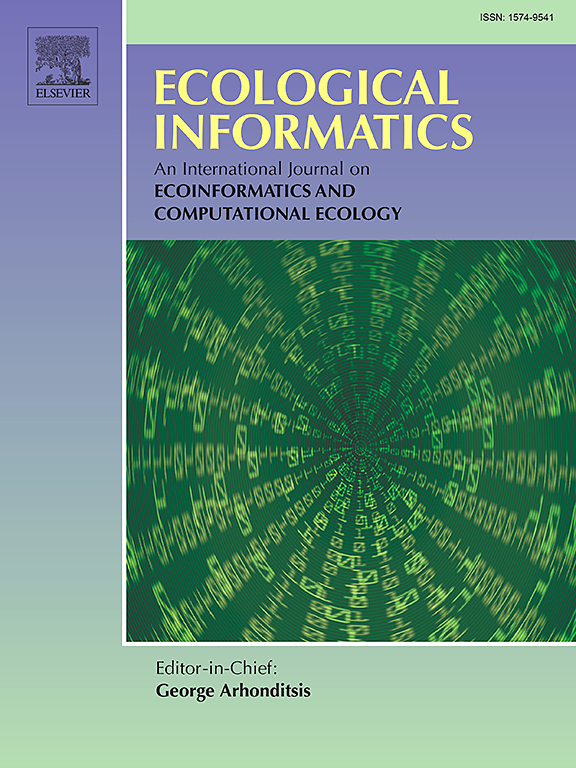基于高空间分辨率图像和改进YOLOv8模型的长江口玻璃鳗鱼捕获设备识别
IF 5.8
2区 环境科学与生态学
Q1 ECOLOGY
引用次数: 0
摘要
虽然鳗鱼养殖已经成为一种产业,但人们仍然无法实现鳗鱼的大规模人工繁殖。因此,养殖鳗鱼只能依靠捕获天然鳗鱼苗,即玻璃鳗。玻璃鳗的捕捞强度对自然鳗鱼资源,特别是野生鳗鱼资源的可持续发展至关重要。中国大陆架是日本鳗鲡生活史上的重要栖息地。中国渔业部门对玻璃鳗鱼捕捞实行了特别许可规定,以控制此类活动的规模和强度。然而,由于存在非法和不报告捕捞偷猎的可能性,在宏观层面上对长江口及中国沿海地区玻璃鳗的捕捞规模还没有完全掌握。针对中国沿海地区特别是长江口地区玻璃鳗捕获监测的问题,本研究通过改进YOLOv8模型,探索了一种利用吉林一号高空间分辨率卫星图像识别和监测玻璃鳗捕获活动的方法。样本数据集通过数据标记创建,并分为训练集、验证集和测试集。为了避免小目标的误检测,我们引入渐近特征金字塔网络取代原有的检测头,并增加小目标的检测层,提高了精度,但增加了参数和计算量。然后,采用双卷积核对C2f模块进行改进,并引入具有增强局部关注网络的空间金字塔池化快速模块,改进池化过程。从而提高了检测速度和精度。在样本数据集上,采用改进的YOLOv8模型进行实验,结果表明,平均精度(mAP@50 %)为94.8%,比原YOLOv8模型提高4.5%。本文提出的改进模型提高了玻璃鳗鱼捕获设备在高空间分辨率图像中对微小目标的定位能力和检测精度,可用于监测玻璃鳗鱼捕获活动和评估玻璃鳗鱼捕获强度。本文章由计算机程序翻译,如有差异,请以英文原文为准。
Identification of glass eel capture equipment in the Yangtze River estuary based on high-spatial -resolution imagery and an improved YOLOv8 model
Although eel farming has become an industry, people still cannot achieve large-scale artificial reproduction of eels. Hence, the recruitment of eel for aquaculture can only rely on the capture of natural eel fry, i.e. glass eels. The capture intensity of glass eels is crucial for the sustainable development of natural eel resources, especially for wild eel stocks. The continental shelf of China is an important habitat in the life history of Japanese eel. China's fisheries authorities have adopted a special permit regulation for glass eel capture to control the scale and intensity of these activities. However, the scale of glass eel capture in the Yangtze River Estuary and along the Chinese coast is not fully grasped at the macro level, because of the possibility of poaching by illegal and unreported fishing. To address this problem of monitoring glass eel capture along the coast of China, especially in the Yangtze River Estuary, this study explored a method for identifying and monitoring glass eel capture activities from high spatial resolution satellite image of Jilin-1 by improving YOLOv8 model. The sample dataset was created by data labelling, and split into training, validation, and test sets. To avoid the false detection of small targets, we introduce the asymptotic feature pyramid network to replace the original detection head, and add a detection layer for small targets, which improves the accuracy but increases the parameters and computation volume. Then, C2f module was improved with dual convolutional kernels, and the pooling process was improved by introducing the spatial pyramid pooling fast module with enhanced local attention network. Thereupon the detection speed and accuracy are both improved. So the experiment was carried out based on the sample dataset using the improved YOLOv8 model, which showed that the average precision (mAP@50 %) is 94.8 %, 4.5 % higher than that of the original YOLOv8. The improved model proposed in this article improved localization ability and detection accuracy of tiny targets of capture equipment for glass eel from high-spatial-resolution images, and hence the method can be used to monitor glass eel capture activities and evaluate the intensity of glass eel capture.
求助全文
通过发布文献求助,成功后即可免费获取论文全文。
去求助
来源期刊

Ecological Informatics
环境科学-生态学
CiteScore
8.30
自引率
11.80%
发文量
346
审稿时长
46 days
期刊介绍:
The journal Ecological Informatics is devoted to the publication of high quality, peer-reviewed articles on all aspects of computational ecology, data science and biogeography. The scope of the journal takes into account the data-intensive nature of ecology, the growing capacity of information technology to access, harness and leverage complex data as well as the critical need for informing sustainable management in view of global environmental and climate change.
The nature of the journal is interdisciplinary at the crossover between ecology and informatics. It focuses on novel concepts and techniques for image- and genome-based monitoring and interpretation, sensor- and multimedia-based data acquisition, internet-based data archiving and sharing, data assimilation, modelling and prediction of ecological data.
 求助内容:
求助内容: 应助结果提醒方式:
应助结果提醒方式:


